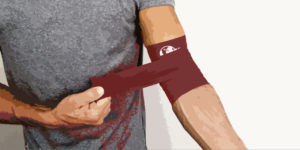Getting and staying rugby fit is hard enough when you have access to a gym and other rugby club facilities. But, when you are away from home and traveling for the summer, it can seem like an impossible challenge.
The last thing most ruggers want to do is lose their hard-earned fitness just because they are away from home. After all, once your travels are over and done you’ll probably want to jump right back in to playing competitively, and not end up on the subs bench because you are out of shape.
One solution is to seek out rugby clubs wherever you are traveling and turn up for team training. Of course, you’ll have to fit in with whatever training session is on that night, but you’ll at least be guaranteed of some form of rugby-specific workout.
Most clubs are only too happy to welcome visiting players from other clubs. Just drop them an email to find out what training sessions are available. Alternatively, you could just find a gym and do some rugby-specific gym training.
If neither of these options are available, why not commit to doing some speed and agility training on the beach, at a park, or even in a conveniently-located hotel parking lot. The reality is that, for a lot of rugby training workouts, all you really need is enough space to run, turn, and jump.
To give your workouts some structure and variety, consider investing in a few pieces of portable equipment. You don’t need a lot and buying them won’t break the bank or exceed your baggage allowance.
Consider equipping yourself with a couple of the following items:
- Agility marker cones – cost about $15-$25.00
- 10-15 meters of elastic rope – cost about $10-$15.00
- PVC jump rope – cost about %5.00
- Loop-type heavy-duty resistance bands – cost about $10-$30.00 each
- A 20-meter length of string with knots tied in it every 5 meters in lieu of a tape measure – cost about $0.25
Armed with just a few of these items, you have all you need to create some effective and fun speed and agility workouts that you can do just about anywhere.
Here are a few workouts that are ideal for traveling ruggers…
T-sprint drill
This drill develops forward, backward, and sideways running speed. Because it involves several changes of direction, it’s also good for agility and reaction time too.
Lay out four marker cones as shown in the diagram below. The cones should be five meters apart. No cones? Use rocks instead.

Start at the base of the T and the sprint forward. Side step out to the left-side cone, and then all the way across to the right-side cone. Side step back to the center and then run backward, returning to your starting point. Rest a minute or two and then repeat. Reach down and touch each cone to add more of an agility demand to this exercise.
Zig-zag sprints
While straight line speed is important in rugby, you need to be able to zig and zag at speed too – unless you like running straight into the opposition that is! This drill is great for developing running speed and agility.
Lay out ten marker cones as shown in the diagram. The cones should be around 2-3 meters apart. The closer the cones, the more agile you’ll need to be.
With a 5-meter rolling start, run through the cones staying as close to the markers as
possible. Make a concerted effort to run in as straight a line as possible and push dynamically off your outside foot. At the end of the cones “lean and go” and sprint out to a final marker 10-15 meters from the last cone.

Band-resisted sprints
This drill is a great way to develop starting speed and drive. Best of all, you only need a few meters of space to do it.
Take 2-3 strong loop-type resistance bands and thread them together. Fix the end of one band at hip height to a sturdy post – such as a bollard. I use an old boxing hand wrap. Stand in the loop at the other end and walk forward to take the slack out of the bands. As the band starts to tighten, sprint forward as far as the band allows. When you reach the end of the band, shuffle backwards and then repeat.
Needless to say, only strong bands are suitable for this exercise, and you should check each band carefully before your workout. A nicked or otherwise damaged band could break and cause injury.
Broken 100s
Lack of space does not have to stop you from working on your speed, agility, and fitness. In fact, with this drill, you can develop a host of rugby fitness components in just 20 meters of space.
Set up your cones as shown below. Use your knotted string as a distance guide.
0—–0 (5 meters)
0———-0 (10 meters)
0—————0 (15 meters)
0——————–0 (20 meters)
Run out to the first marker and then back. Immediately turn and run out to the second marker and back. Continue out to the third marker and back, and finally out to the forth marker and back. Congratulations – you have just run 100 meters! Rest for 60 to 90 seconds and then repeat. If you are new to this kind of workout, perform three to five repeats. For a more demanding workout, perform more repetitions.
An especially challenging variation of broken 100s involves running a broken hundred at the top of each minute for 10 minutes. This is a tough workout, but its brevity makes it tolerable – just!
If you are after sprinting quality as well as quantity, perform three sprints, rest five minutes, perform another three sprints, rest a further five minutes, and then perform a final set of three. The longer rests should mean that you can maintain a faster sprinting speed throughout the entire workout.
Duck under/jump over
This drill will develop your agility and jumping ability. It’s also good for lower body mobility and a few reps will soon leave you gassed too!
Take your ten-meter elastic rope and stretch it between two posts – such as soccer goal posts – at around butt-height. Stand right-side on to the rope, starting at one end. Duck down and step sideways under the rope. Quickly stand up and jump forward and sideways over the rope. Keep going until you have travelled the length of the rope. Make sure that, for your next set, you start left-side on to keep things balanced.
Double unders and sprint
When you do double unders, the rope must pass under your feet twice per jump. This develops agility, coordination and explosiveness, not to mention a high level of fitness. This drill combines double unders with a short sprint. Perfect for developing rugby-specific conditioning when space is limited.
Do 10-20 double unders, drop your rope, and immediately sprint ten meters. Stay low and do your best to instantly turn vertical movement (the double unders) into horizontal movement (the sprint). Walk back to the start, catch your breath, and repeat.
Can’t do double unders? Squat jumps will suffice.
Belly and back start sprints
A lot of sprint situations in rugby start after you’ve lost your feet and are on your belly or your back. Replicate that by starting some of your sprints from the prone (belly) or supine (back) position. You can add belly and back starts to T-sprint drills, zig-zag sprints, broken hundreds, and the duck under/jump over drill.
Travelling does not have to mean you can’t improve rugby-specific speed and agility. With a little space, some planning, and a pinch of imagination, you should be able to maintain and even increase your rugby performance with nothing more than a little space to run and a few pieces of portable equipment.


